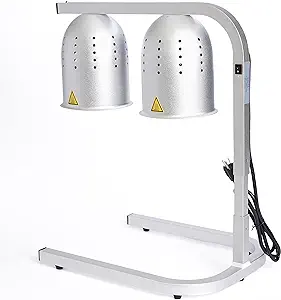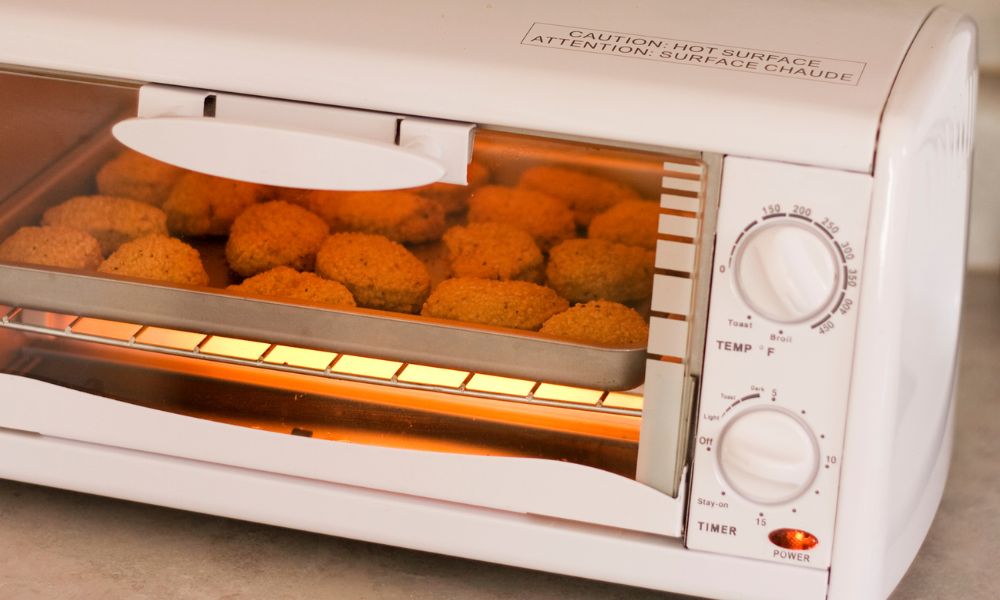By John Bird, former chef and barista at Boat Basin Cafe
To keep your fish and chips warm and crispy, all you need is a low oven temperature.
Don’t wrap them up tight – this will make them soggy. Instead, use a wire rack to keep that perfect crunch. 🐟🍟
Jump to Step by Step Instruction
Rewind a few years, picture me bustling around the kitchen at Boat Basin Cafe in downtown New York. We weren’t just slinging fries and cod – we were crispy crusaders, dedicated to keeping those golden beauties perfect until the last bite.
Forget soggy disasters or lukewarm disappointments. Here’s the Boat Basin secret sauce for keeping your fish and chips hot and irresistible, even long after they leave the fryer, backed by the sizzle of science!

Science of Crispness and Food Safety
Remember the satisfying sizzle of the fryer at Boat Basin? That wasn’t just magic, it was the Maillard reaction in action!
This chemical dance between proteins and sugars at high temperatures (around 350°F) creates the golden crust we crave and those irresistible savory flavors. (Check out this review paper for a deeper dive: [https://pubmed.ncbi.nlm.nih.gov/34137312/])
But the heat isn’t just for browning; it also sears the fish, trapping precious moisture inside and preventing dryness.
But leave them hanging out in that heat too long, and the moisture wins, turning everything limp and sad. That’s where moisture control becomes our scientific hero. The hot oil creates a crispy barrier, but the fluffy potato interior traps steam, a potential sog-fest waiting to happen. That’s why keeping things at the right temperature and ensuring air circulation are key.
Temperature and Food Safety
Back at the cafe, we had this down pat. As soon as a batch came out of the fryer, we’d pop them onto wire racks perched over baking sheets. This clever trick allows air to circulate freely, preventing steam from becoming the soggy monster.
Think of it like giving your fish and chips their own little dance floor – space to keep the crunch alive! This technique aligns with studies on the impact of packaging on food moisture content, where proper ventilation is crucial for preventing sogginess.
Keeping food safe to eat is all about temperature control. For fish and chips, it’s essential to keep them out of the danger zone, which is between 41°F and 135°F.
This is where harmful bacteria can grow. To keep your fish and chips safe, it’s a must to either keep them hot, above 135°F, or cool them quickly if you’re not eating right away.
Moisture and Sogginess
Moisture and steam can quickly turn your crispy chips soggy, a plight familiar to any food connoisseur. Ventilation is the answer. By allowing steam to escape, we ensure that the batter stays crunchy.
Find more invaluable kitchen tips including maintaining the crispness in our guide to keeping food warm for a party.
Techniques on How to Keep Fish and Chips Warm in the Oven
Now, the oven wasn’t just a storage unit – it was our secret weapon. But blasting them on high heat would be like throwing another log on the fryer fire. We kept it nice and low, around 200°F.
That’s warm enough to stay above the danger zone (140°F) for happy and healthy bacteria, as outlined by the USDA food safety guidelines, but not hot enough to cook them further.
Think of it as a gentle hug, keeping them warm and happy without overdoing it.

Step by Step Instruction:
- Preheat your oven to a low temperature, around 200°F. This is hot enough to keep food safe but not so hot that it continues to cook.
- Place your fish and chips on a wire rack over a baking sheet. The rack lets air circulate around the food, preventing steam from making things soggy.
- Leave the oven door slightly ajar. This can help steam escape, though it’s optional based on how your oven circulates air.
Pro Tips from the Cafe

Don’t wrap it tight: Remember those foil tents we used at Boat Basin? They weren’t just for show. Tightly wrapping traps steam, so give your fish and chips some breathing room. A loose foil tent is your friend for keeping the heat in without causing a soggy meltdown.
Time flies when you’re having fun (and eating fish and chips): Don’t let them hang out in the oven for too long! 30 minutes is the golden rule. Any longer, and they might start to dry out. Remember, we want that perfect balance of crispy and hot, not crispy and dusty!
Oven variations: Not all ovens are created equal. Convection ovens circulate air like a champ, so you might need to lower the temperature a bit (around 25°F) to avoid overcooking. For regular ovens, keep an eye on your food and rotate the tray occasionally for even heat distribution.
Oven Types and Their Impact on Keeping Fish and Chips Warm

The type of oven you use can affect how well your fish and chips maintain their warmth and crispness. A conventional oven can sometimes create pockets of warmer air, which means you may need to rotate your tray for even warming.
In contrast, a convection oven uses a fan to circulate air, which can help in removing the moisture around your fish and chips, keeping them crispier. If you’re using a convection oven, you might need to lower the temperature by about 25°F, as they tend to be more effective at heating.
Alternative Methods
While the oven is a great tool, you’ve got other options to keep your fish and chips in prime condition.

At the cafe, we sometimes used warming lamps for food waiting for table service. These lamps are designed to keep food warm without cooking it further.
For home use, insulated food containers can be a good alternative, trapping the heat and slowing down heat loss.
Comparatively, these methods can maintain warmth but may not be as effective as an oven in preserving crispiness over longer periods.
The Best Fish Varieties for Long-Lasting Warmth and Crispiness
Selecting the right type of fish is crucial for that perfect fish and chips experience. Some varieties are better suited for staying crispier longer when kept warm.
Choosing the Right Fish 🐠
Thicker, firmer fish like cod or haddock tend to maintain their structure and crispiness better under heat. These varieties are commonly used in traditional fish and chips for a reason—they withstand the rigors of frying and warming without falling apart.
Fish Selection for Takeout or Home Cooking 👨🏻🍳
For takeout, ask what fish is used and opt for those thicker varieties. When cooking at home, choose fish with lower fat content, as this often indicates a firmer texture which is good for maintaining crispiness.
Eco-Friendly Solutions to Heat Your Seafood
In today’s world, it is essential to consider the environment even when keeping our dinner warm. Here are some eco-friendly techniques that are kind to the planet and your fish and chips.

- Use a Toaster Oven: Smaller than conventional ovens, toaster ovens heat up quickly and use less energy.
- Insulated Bags: These bags, often made with sustainable materials, keep food warm without the need for additional energy.
- Batch Cooking: If you’re heating other food, place your fish and chips in the oven at the same time to make the most of the heat.
Another creative solution is using a preheated ceramic or stone tile in your oven that retains heat well and slowly releases it, reducing the need for prolonged oven use.
Cookware and Accessories
The cookware you choose can significantly impact how well your fish and chips stay warm and crispy.
Pros and Cons of Different Warmth Retainers
| Material | Pros | Cons |
|---|---|---|
| Foils | Convenient, traps heat | Can cause sogginess if not tented |
| Containers | Can be insulated, retains heat | May not allow for crispness retention |
| Chafing Dishes | Professional, retains heat well | Bulky, more suitable for large events |
Best Cookware Materials
Stainless steel or aluminum chafing dishes are ideal for large gatherings, but at home, a ceramic dish can be effective. It’s all about keeping the crisp alive, just like we did in the cafe kitchens.
Troubleshooting Common Warmth Maintenance Issues
If your kitchen is particularly humid, try using a dehumidifier to help keep the area dry, reducing the risk of sogginess. Also, using an oven thermometer can ensure you’re at the ideal 200°F mark to avoid overcooking your food.
Takeaways
- Select firm-fleshed fish varieties for better crisp retention.
- Use a low oven temperature and a wire rack to maintain warmth without sogginess.
- Consider eco-friendly options like toaster ovens or insulated bags.
- Choose the right cookware — ceramic or stainless steel can help retain crispiness.
- Watch the clock — don’t keep fish and chips warm for more than 30 minutes to maintain quality.
The Final Bite
Keeping your fish and chips hot and crispy isn’t just about science, it’s about Boat Basin love. We cared about every plate, and these tips are a taste of that passion.
..So go forth, fry, crisp, and keep those golden beauties singing with every bite! Remember, with these tips and a sprinkle of Boat Basin love, you can serve up perfectly crispy fish and chips every time, no matter the kitchen. Don’t forget to share your own crispy creations and tag us on social media – we love seeing your fish and chips adventures! Now get cookin’, and remember, a happy crunch is a sound worth savoring.
Stay safe, eat well, and have fun in the kitchen!
P.S. If you’re feeling extra adventurous, try experimenting with different dipping sauces, like a tangy tartar sauce or a creamy garlic aioli. The possibilities are endless!